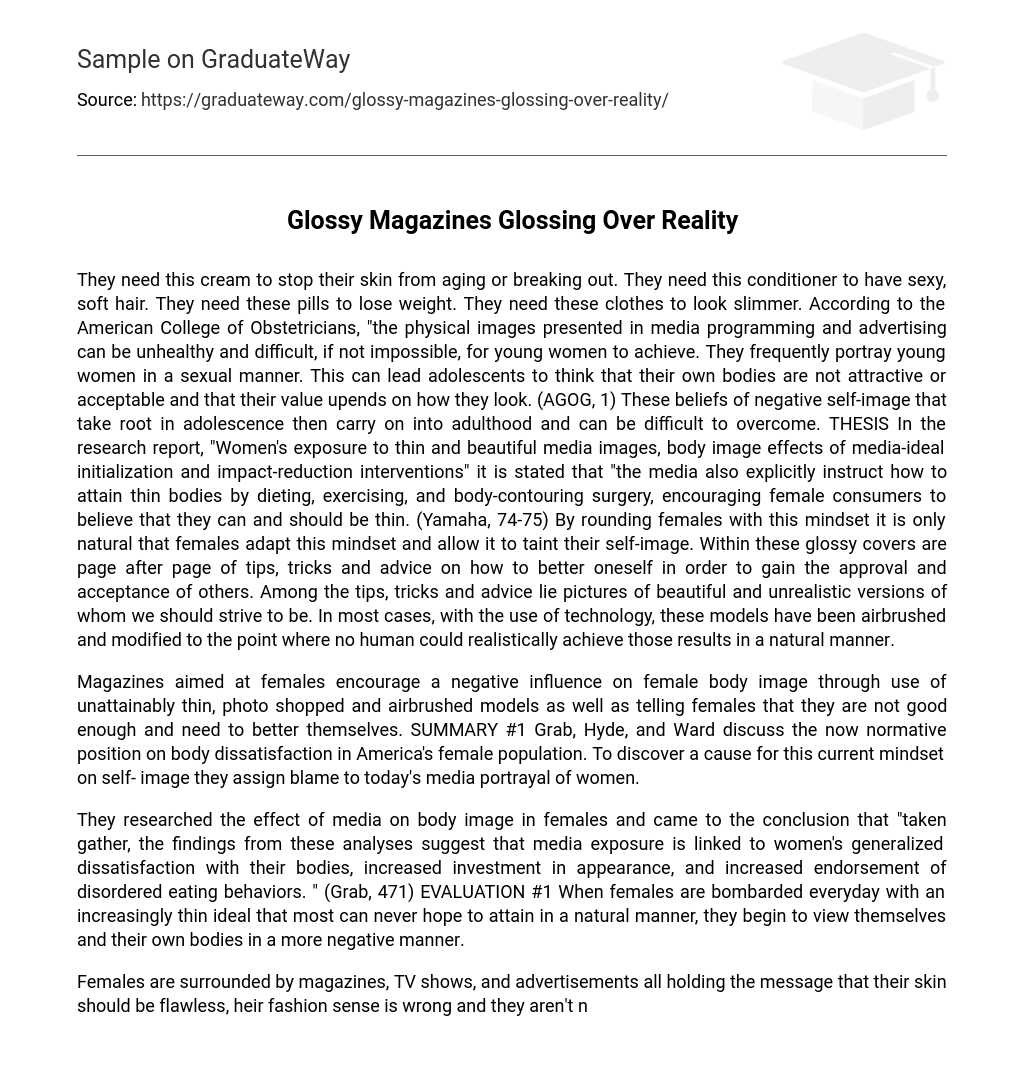They need this cream to stop their skin from aging or breaking out. They need this conditioner to have sexy, soft hair. They need these pills to lose weight. They need these clothes to look slimmer. According to the American College of Obstetricians, “the physical images presented in media programming and advertising can be unhealthy and difficult, if not impossible, for young women to achieve. They frequently portray young women in a sexual manner. This can lead adolescents to think that their own bodies are not attractive or acceptable and that their value upends on how they look. (AGOG, 1) These beliefs of negative self-image that take root in adolescence then carry on into adulthood and can be difficult to overcome. THESIS In the research report, “Women’s exposure to thin and beautiful media images, body image effects of media-ideal initialization and impact-reduction interventions” it is stated that “the media also explicitly instruct how to attain thin bodies by dieting, exercising, and body-contouring surgery, encouraging female consumers to believe that they can and should be thin. (Yamaha, 74-75) By rounding females with this mindset it is only natural that females adapt this mindset and allow it to taint their self-image. Within these glossy covers are page after page of tips, tricks and advice on how to better oneself in order to gain the approval and acceptance of others. Among the tips, tricks and advice lie pictures of beautiful and unrealistic versions of whom we should strive to be. In most cases, with the use of technology, these models have been airbrushed and modified to the point where no human could realistically achieve those results in a natural manner.
Magazines aimed at females encourage a negative influence on female body image through use of unattainably thin, photo shopped and airbrushed models as well as telling females that they are not good enough and need to better themselves. SUMMARY #1 Grab, Hyde, and Ward discuss the now normative position on body dissatisfaction in America’s female population. To discover a cause for this current mindset on self- image they assign blame to today’s media portrayal of women.
They researched the effect of media on body image in females and came to the conclusion that “taken gather, the findings from these analyses suggest that media exposure is linked to women’s generalized dissatisfaction with their bodies, increased investment in appearance, and increased endorsement of disordered eating behaviors. ” (Grab, 471) EVALUATION #1 When females are bombarded everyday with an increasingly thin ideal that most can never hope to attain in a natural manner, they begin to view themselves and their own bodies in a more negative manner.
Females are surrounded by magazines, TV shows, and advertisements all holding the message that their skin should be flawless, heir fashion sense is wrong and they aren’t nearly as thin as they should be. By being subjected to these messages every day, females’ body image has decreased to the point that being dissatisfied with your body has become the normative. Confidence in your body has now become so rare that it is now confused with arrogance.
SUMMARY #2 (with long quote) In an article entitled “The Effect of Thin Ideal Media Images on Women’s Self- Objectification, Mood, and Body Image” by Bruit Harper and Marina Tightening, it is discovered through experimentation that women feel worse after viewing magazines tit thin body images and that women are objectified in the media. It was also discovered that after viewing the media where women are objectified, the female viewer also begins to objectify herself. Harper and Tightening observe that when levels of self-objectification are high, negative view of image is also present.
This self- objectification is raised when in magazines there are not only thin models but attractive men looking upon them as well. According to Harper and Tightening “Women who viewed thin-idealized magazine advertisements demonstrated higher bevels of state self-objectification, weight-related appearance anxiety, negative mood, and body dissatisfaction… ” (Harper,655) Harper also discusses the thin-idealized model and the effect on body image. In particular, fashion and beauty magazines have been accused of leading the charge in disseminating the thin ideal.
One content analysis of 69 American women magazines revealed that 94% displayed an image of a thin-idealized model or celebrity on the cover. By failing to present a diverse range of body types, fashion magazines promote thinness as both desired, and more insidiously, the prevailing arm for women. Implicit is the suggestion that a deviation from this thin ideal is abnormal. It is therefore not surprising that thin-idealized images featured in fashion magazines can stimulate body image disturbance in girls and women. Harper, 649) EVALUATION #2 Objectification of women in advertising can cause women to objectify themselves, thus seeing themselves solely as a body, and not including their mind or personality as part of the whole. As more emphasis is put on appearance and the thin-idealized models and celebrities, negative body image is becoming more prevalent in girls and omen. Viewing fashion magazines can even be a predictor of body dissatisfaction as well as eating disorders.





